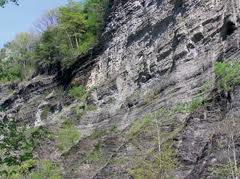Report of Radioactive Wastes from Marcellus Shale Fracking
From the Article of the Binghamton Examiner, www.examiner.com, October 2, 2013
A new study conducted by Avner Vengosh, professor of geochemistry and water quality at Duke University’s Nicholas School of the Environment, and colleagues is the first to report substantially higher than normal levels of radioactive waste in the effluent waters processed from the hydraulic fracturing in the Marcellus Shale area of Pennsylvania. The research was reported in the October 2, 2013, issue of the journal Environmental Science & Technology.
Radium levels were 200 times higher downstream from the Josephine Brine Treatment Facility (hydraulic fracturing waste water treatment plant) than upstream in the Blacklick Creek. The treatment plant is state of the art and has been approved by the EPA.
The problem is that over time the accumulations of radioactive radium in the sediments down stream from the treatment plant have risen above what is considered a safe limit for drinking water. The potential duration of this radioactive contamination is thousands of years.
The researchers also found much higher levels of barium, bromide salts, and chloride salts in the water downstream from the treatment plant than above the plant.
The scientists recommend that operations be suspended until sufficient equipment can be installed to mitigate the pollution problems that are produced from shale oil production in any form.
NOTE: See also the more complete Article here.


{ 1 comment… read it below or add one }
Help me understand these circumstances. If the Marcellus shale seam in radioactive in place underground, then what happens to that radioactivity when the drill cuttings from the horizontal drilling are brought to the surface. These cuttings are placed in large trucks, moved on our highways and hauled to landfill dumps, is that correct?
And, at these landfill sites, the tonnage of drill cuttings accumulates, gets rained on, leaching occurs, and runoff goes into our streams, our runs, our creeks, our rivers. And, this without inspection, monitoring, regulation or treatment? Is that correct?